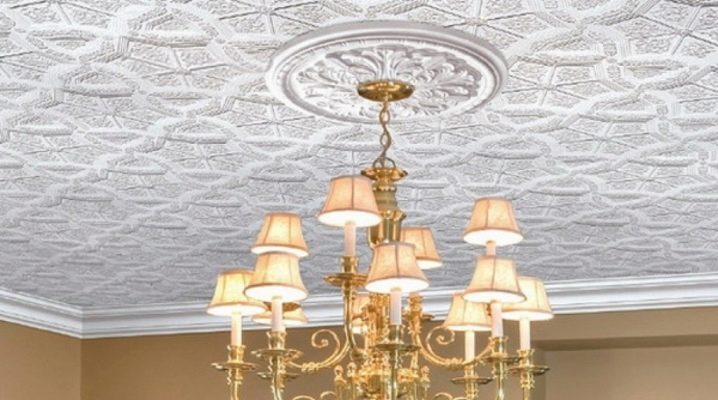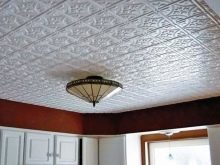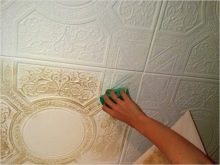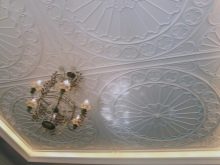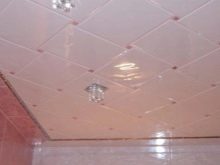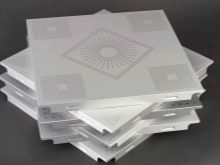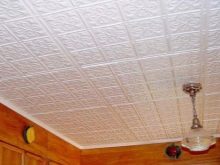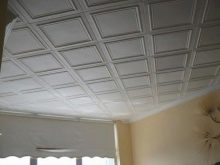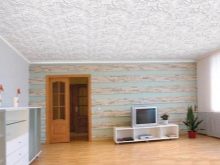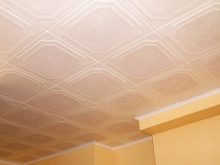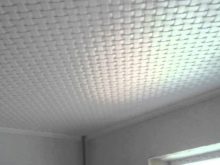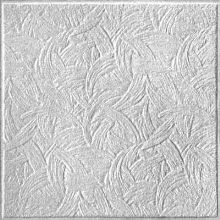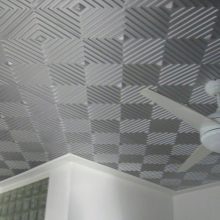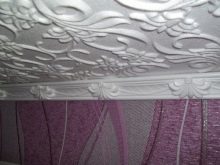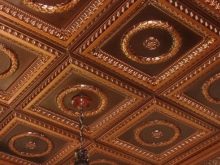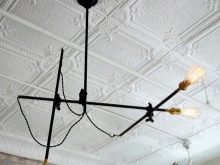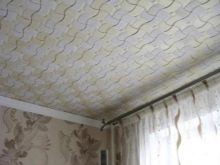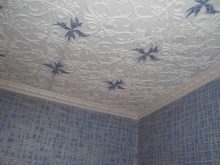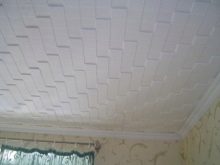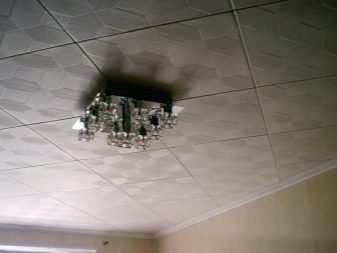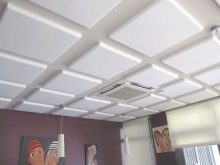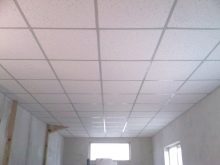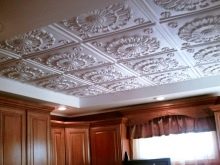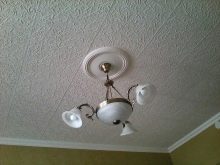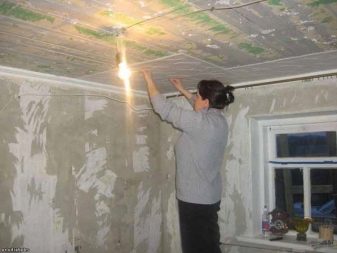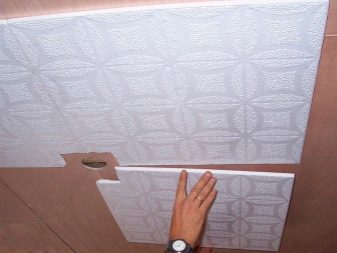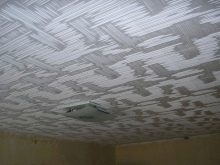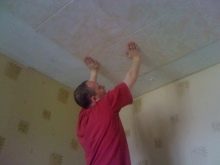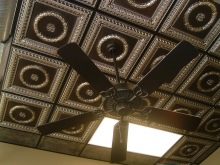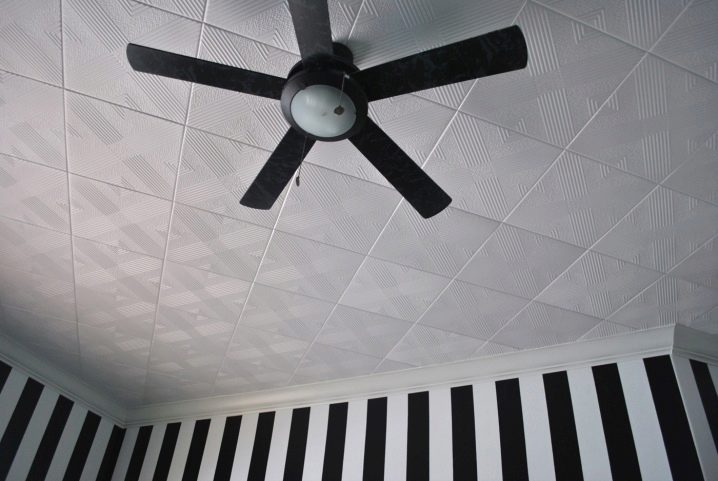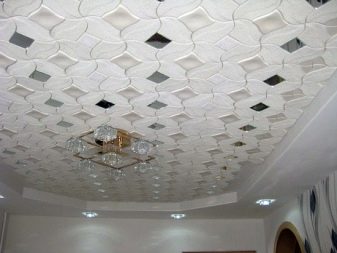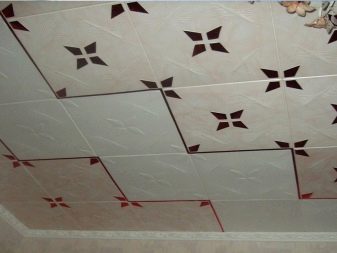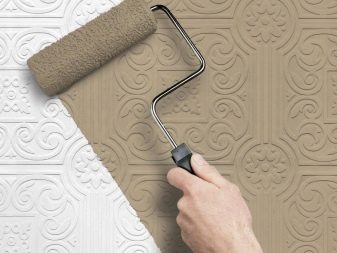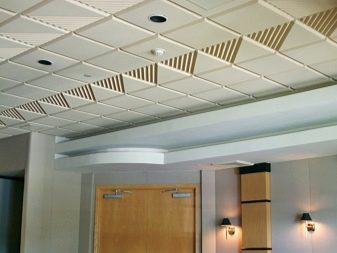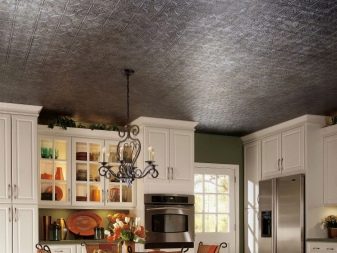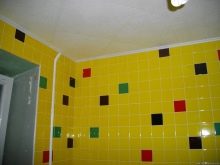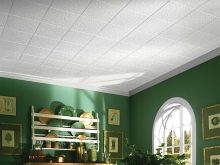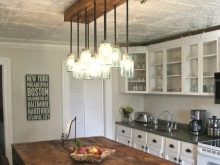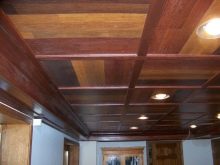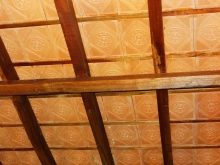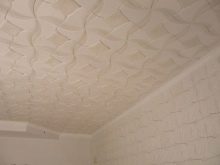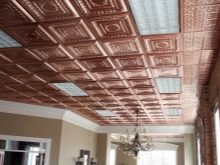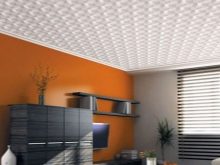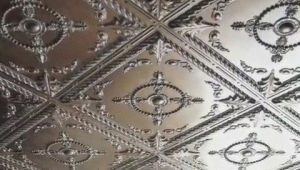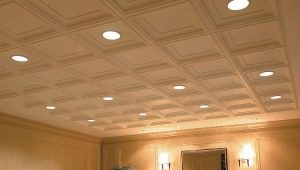Ceiling tile from polyfoam: versions and features of use
The cheapest and easiest way to finish the ceiling is the installation of foam tiles. At cost, such work can be equated to traditional whitewash, but unlike it, the design is much more efficient, as it opens up tremendous opportunities for creative ideas. This material has a rich texture and color, simulates various surfaces and is decorated with beautiful embossed patterns. Depending on the style, you can choose a classic white tile or colored panels with stucco.
The installation of such a ceiling is not complicated, so you can do it yourself, without having special skills for this.
Distinctive features
Foam tile is very popular in the ceiling design, as it is a budget material, thanks to which you can quickly and stylishly decorate any floor. It is well suited for the decoration of residential premises, offices and country extensions.. The tiles are produced in various sizes from ecological raw materials, and a special processing technology makes the material resistant to high humidity and sudden temperature changes. To date, the construction market is represented by a chic selection of PVC tile modifications, so buying a suitable option will not be difficult, in addition, the product can be painted and perfectly hides all the flaws of the ceiling.
Performing the finish in this way, interesting patterns can be obtained on the surface of the ceiling, they are evenly distributed over the entire base, but often form seams, so for a perfect finish it is recommended to purchase a special seamless tile. Its panels are characterized by a snow-white shade and look beautiful in spacious rooms.
In addition to all this, other advantages can be distinguished in the foam tile:
- Low price. Compared with the installation of complex suspended structures and decorative plaster, the material allows you to beautifully arrange the ceiling without significant financial costs.
- Easy installation. The panels are lightweight and can be fixed with mounting glue.In addition, the material is quickly cut and acquires the desired size or shape. Installation work is carried out without the formation of dust and debris.
- Easy care. The product is not afraid of water, so wet cleaning is suitable for it.
- Good heat and sound insulation.
In addition to the positive properties, the ceiling tile has its drawbacks, namely:
- The room, covered with foam panels, requires high-quality ventilation, since in a closed room, stuffiness and heavy air can form.
- The installation of the tile is carried out on the previously prepared ceiling, so its surface must be carefully leveled and primed. This, of course, entails additional costs, but if you do not eliminate visible defects, then the finishing material can repeat all the bumps.
- No matter how well laid tile, joints can not be avoided. Therefore, all seams must be sealed.
- Foam panels are easy to cut, but can crumble and break. Such cut-out elements in further operation may fail, since their integral structure will break and they will differ significantly from the industrial counterpart.
Kinds
Foam tiles is a unique finishing material, as they are made of various shapes. To date, the sale can be found square panels with a length of 50 cm and rectangular. Hexagon and rhomboid tiles are also very popular, they look unusual in design and create original patterns.
Depending on the production technology, the following types of material are distinguished:
- Stamped. Panels are manufactured from polystyrene blocks by the method of special stamping. Such tiles have a low weight, low density, their thickness does not exceed 8 mm. Products are characterized by a relief structure and are inexpensive. Since the panels are not covered with a protective film, they are subjected to mechanical stress and are afraid of wet cleaning. In addition, when installing between the plates may be small gaps that need to be sealed.
- Extruded. Panels are made by pressing polystyrene raw materials. They are characterized by high density and thickness of 3 mm. Additionally, the material is covered with a protective layer, which protects it from damage and dust.As a rule, such tiles imitate wood and marble, it is reliable in operation, but due to the presence of connecting joints it cannot be painted.
- Injection. Products are produced under conditions in which polystyrene is baked in molds. This type of panels, in contrast to the previous versions, is distinguished by high strength and thickness. In addition, the patterns deposited on the surface of the material, have an unusual geometry and relief. The decorative tile at installation looks integral and its seams are almost imperceptible. This ceiling does not burn, it can be washed with detergents and painted in any color.
Special attention also deserves the seamless ceiling tiles, thanks to which the surface looks monolithic and smooth.
The edges of the panels have a special shape, so the joints that appear during its installation, the original "hide" and become invisible. For this type of tile there is a separate technology of laying and its mounting is performed with the help of glue, which dries quickly.
How to choose?
The ceiling plays a huge role in the design of the design. Not only the atmosphere of the room, but also the appearance of the space depends on its decor.Therefore, you need to choose the finishing material for the ceiling correctly.
To make the tiles look beautiful in the room and reliably serve for many years, it is recommended that when buying them pay attention to the following points:
- Shape and edges. The material must have clear lines and borders. You can not choose a tile with deformed and curved edges, as this can lead to many problems during installation.
- Material structure. Panels should have a uniform density around the perimeter. It is not allowed to use products that have edges crumbling and dents or waves are present.
- Picture. It should be preferred tile with clear patterns.
- The size. Each panel in the kit should be the same width and length.
- Design. Traditionally, the material is available in white colors, but to save yourself from future painting, you can immediately buy the panel of the desired color. Beautifully look also cover under a tree or a natural stone. In addition, PVC tiles are matte and laminated, it is recommended to pre-examine its samples, and only then give preference to one or another variant.
It is also advisable that before choosing a decorative product, review customer reviews and purchase tiles only from well-known and well-tested manufacturers who can provide the appropriate quality certificates.
Installation Features
Polyfoam is considered one of the most affordable materials that can quickly and easily decorate the ceiling. To tile looked aesthetically pleasing, it must be properly installed, adhering to certain technologies.
The process of pasting foam panels begins with the preparatory work, which consists of the following steps:
- Wall covering. It is carried out before installing the tile, as the glue may stain the decorative coating. If the wall decoration in the repair is not provided, then they are simply covered with a film.
- Disassembly and cleaning. All sources of lighting are removed and electrical wiring is isolated. The old coating is removed and stains from rust, fungus, grease and soot are eliminated.
- Puttying. A thick cement mortar is prepared and plastered.
- Padding. It can be made from ready-made mixtures, or you can prepare them yourself from water and PVA glue.It is advisable to cover the ceiling with a primer, which includes antifungal components.
- Grinding. The surface is checked for evenness and, if necessary, the starting putty is additionally applied, after which the base is ground and fixed with acrylic.
Ceiling tile is glued to any surface. To fix it, you need to pre-select a convenient scheme and only then proceed to installation. The most commonly used diagonal, parallel and combined placement of panels.
Parallel the installation starts from a noticeable angle in the room and looks like this:
- Glue is applied to the tile. They cover the perimeter of the reverse side and make an additional fixation in the middle. At the same time it is necessary to control the layer of glue, because if it is thick, then traces may remain, and the seams will become much more noticeable.
- The cloth is pressed to the base of the ceiling and smoothed. The next panel is mounted similarly, but its patterns should be a continuation of the first tile and look symmetrical.
- After the row is completed, measure the seams and the distance to the wall.
- The final stage will be the ceiling decoration skirting boards, which are selected from the same materialas tile. They are also fixed with glue.
As for the diagonal installation, it starts from the center of the ceiling. In the event that a chandelier is planned to be placed in the center, the edges of the panels are trimmed, and the resulting hole is then easily closed with a plug.
Installation work in this case is performed as follows:
- A ceiling marking is made, along which the first panel is fastened in the very center. At the same time its angles must strictly correspond to the middle of the lines.
- The second tile is installed along the deposited axes, then the work is continued similarly until completion. Installation of the last row will be carried out with the cut parts.
With combined placement of ceiling elements glue is applied simultaneously to the surface of four plates, after which they are immediately attached to the base. All work must be done strictly according to the markup, and the extreme row is laid out from pre-cut blanks. This technique is considered to be difficult, therefore it is not recommended for beginners.
How to glue the ceiling tiles, see the following video.
What can be painted?
The ceiling tile from polyfoam is made various flowers and invoices,but many craftsmen prefer to purchase a material with a white surface, after which it is additionally decorated with paint. It is worth noting that the painting of foam panels allows not only to give the material an aesthetic look, but is also characterized by many positive characteristics. It acts as a protective layer and strengthens the structure of the product. Besides, painted tiles are not so quickly polluted and easier to clean.
In order for the works to be performed qualitatively, it is necessary to choose a good paint that will transform the appearance of the panels and prolong their service life. Usually high adhesion paint is used for ceiling tiles, having resistance to moisture and detergents.
In addition, dyes must be made from components that do not dissolve the foam.
For these works, the following paint options are recommended:
- Acrylic. The mixture belongs to the water-dispersion group, it is made from polymeric and acrylic resins. It dries quickly, has no smell, is easy to use and does not harm human health. After such painting the surface of the ceiling is covered with a vapor-permeable film, so the material "breathes".In addition, this type of paint does not fade, is not afraid of temperature changes and is represented by a huge selection of color palette.
- Water emulsion. It is an emulsion containing water, various polymers and coloring pigments. It is inexpensive, evenly distributed over the surface, dries quickly and does not leave marks and stains from a brush or roller. The only thing that this paint can not be applied in a thick layer, otherwise the film will begin to peel off and crack. Also the tile painted by this solution will absorb dust and fat much faster. It is impossible to wash it with detergents, therefore it is not recommended to paint in the kitchen, where there is a constant accumulation of soot and grease.
It should be noted that the foam tile can not only be painted, but also whitened. This option is most suitable for rooms with high humidity.
How to wash?
Any decorative coating becomes dirty over time and needs to be cleaned. Is no exception to this and the foam tile. As a rule, it is cleaned with a vacuum cleaner, but if after such cleaning there are traces of fat and soot, it is recommended to perform washing.
Many are afraid to wash the ceiling panels, as they believe that this can disrupt the structure of the material and spoil the finish. In fact, it is not Foam well tolerates contact with water and withstands chemical exposure to detergents.
As a detergent, it is recommended to choose the usual soap solution, it will perfectly eliminate not only cobwebs, dust, but also other types of pollution.
As for the kitchen, then it will require more effective means that can cope with the film of fat. In this case use detergents that wash dishes or laundry detergents. But they often contain whitening elements and can harm the appearance of the ceiling. It is undesirable to wash the panels and powders, especially for products with a laminated and glossy surface.
The process of washing ceiling tiles is very simple. To this end, the surface of the ceiling is covered with foam or washing solution, and after the mixture has completely penetrated into all the cavities and drawings, it is wiped with a damp cloth. In that case, if the cleaning did not give the desired result, the solution is applied again, and the remaining water is removed with paper napkins.At the end of the wash, the surface of the panels should remain clean and dry.
It is impossible to press hard on a sponge or a rag during cleaning, as bulges and dents may appear on the panels.. In addition, it is not allowed to clean the drawings with hard objects and hard brushes, otherwise the surface of the ceiling will lose its aesthetics.
Examples in the interior
Special attention should be paid to the modern interior decoration of the ceiling with foam tiles with a laminated surface. It looks bright and stylish, allows you to originally decorate the room, give it an unusual look. Since the ceiling panels of this type are decorated with beautiful drawings, they can be safely used for a classic design. Tile with three-dimensional patterns is well suited for interiors of rooms in which renaissance details prevail. To make such a ceiling harmoniously fit into the overall design style, it must be supplemented with beautiful furniture and exquisite wall decoration.
An unusual idea would also be in the interior of the room laminated tile imitating wood.. It will ideally be in harmony with the style of Provence and the chalet.In order for the image of the room to acquire the finishing touch, you need to lay laminate or parquet in the room, and decorate the walls with wooden inserts. It is best to give preference to panels with a smooth surface.
An interesting option for finishing the ceiling is considered to be a seamless foam tile. Thanks to its special structure, the surface is solid. In addition, similar panels often decorate with stucco and imitate various natural materials. With this tile, you can translate into reality any design ideas. You can use either the white shade of the panels, or choose a color design. It is important to pay attention to the decoration of the walls and flooring, remember that the design should not be more than three colors.
For spacious rooms, it is desirable to choose curly foam tiles. She will create an original composition, and beautiful patterns will favorably emphasize the general theme of the style. Such panels look great in living rooms and halls, and the white ceiling is perfect for bedrooms. In order to separate the ceiling from the original walls, you need to additionally paste the baseboard. It does not interfere in the room and bright lighting in the form of a large chandelier.
